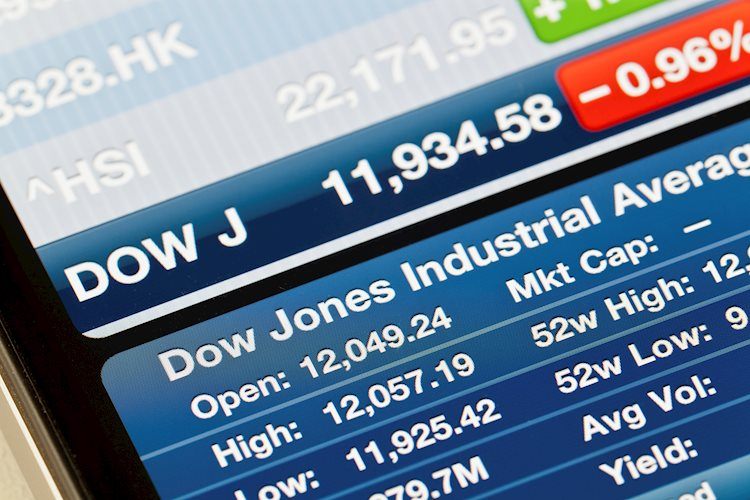- The Dow Jones huddled close to 42,000 to kick off the new week.
- Investors are awaiting key US labor data due on Friday.
- Despite quiet Monday, the Dow Jones is coming off a winning month.
The Dow Jones Industrial Average (DJIA) was hamstrung at the start of a fresh trading week. The major equity index eased slightly on Monday, but stuck close to the 42,000 level. Stock traders are eyeing data risks and rate markets are grappling with the odds of a follow-up cut from the Federal Reserve (Fed) in November.
Market focus will be slowly swinging around toward Friday’s US Nonfarm Payrolls report as investors look for further data on the state of the US economy. Rate traders continue to muse over November’s Fed rate call, with odds tipped slightly in favor of a meager 25 bps cut. However, many market participants are still hoping for a follow-up double cut for 50 bps when the Fed gathers again for another rate call on November 7.
A looming port strike along the East and Gulf Coasts is hampering investor expectations for economic activity in the near term, crimping investor demand and cooling stock advances. Adding to downside pressure in equities, Fed officials drew a line in the sand on Fed rate cuts, noting that it would take a further deterioration of the US labor market to spur further large moves from the Fed. This proposition weighs poorly on otherwise rate-cut-hungry market participants, as further declines in jobs data would signal greater risk of an impending US recession.
Dow Jones news
The Dow Jones is broadly weaker on Monday, with over two-thirds of the stock index testing into the red early in the new trading week. However, firm gains for major components are helping to constrain broader losses in the DJIA.
Boeing (BA) is getting weighed down by its own ongoing strike, which has now gone on for two weeks. The aerospace company shed 2.45% on Monday, slipping below $125.50 per share. On the high side, Apple (AAPL) rose 1.6% to over $231 per share despite the company announcing it was walking away from a capital-raising round for a planned investment into OpenAI. Apple’s pullback from an investment into a major AI project has raised some eyebrows, flashing warning signs that OpenAI’s recent pivot into seeking profitability may have some roadblocks on the way ahead.
Dow Jones price forecast
Despite a tepid Monday, the Dow Jones is set to chalk in a stellar September performance. The major equity index hit a record new high last week of 42,636, and added over 1.5% over the month. The Dow Jones is on pace to close for a fifth consecutive month in the green, climbing over 13.5% bottom-to-top from April’s lows near 37,550.
Dow Jones daily chart
Fed FAQs
Monetary policy in the US is shaped by the Federal Reserve (Fed). The Fed has two mandates: to achieve price stability and foster full employment. Its primary tool to achieve these goals is by adjusting interest rates. When prices are rising too quickly and inflation is above the Fed’s 2% target, it raises interest rates, increasing borrowing costs throughout the economy. This results in a stronger US Dollar (USD) as it makes the US a more attractive place for international investors to park their money. When inflation falls below 2% or the Unemployment Rate is too high, the Fed may lower interest rates to encourage borrowing, which weighs on the Greenback.
The Federal Reserve (Fed) holds eight policy meetings a year, where the Federal Open Market Committee (FOMC) assesses economic conditions and makes monetary policy decisions. The FOMC is attended by twelve Fed officials – the seven members of the Board of Governors, the president of the Federal Reserve Bank of New York, and four of the remaining eleven regional Reserve Bank presidents, who serve one-year terms on a rotating basis.
In extreme situations, the Federal Reserve may resort to a policy named Quantitative Easing (QE). QE is the process by which the Fed substantially increases the flow of credit in a stuck financial system. It is a non-standard policy measure used during crises or when inflation is extremely low. It was the Fed’s weapon of choice during the Great Financial Crisis in 2008. It involves the Fed printing more Dollars and using them to buy high grade bonds from financial institutions. QE usually weakens the US Dollar.
Quantitative tightening (QT) is the reverse process of QE, whereby the Federal Reserve stops buying bonds from financial institutions and does not reinvest the principal from the bonds it holds maturing, to purchase new bonds. It is usually positive for the value of the US Dollar.
Read the full article here

